
How to Learn Julia
Julia, which started development in 2009, is today a popular programming language. Julia is used by millions of data science and statistical computing developers around the world. The programming language is dynamic because it is designed with efficiency in mind.
How do you learn Julia? That is the question we are going to address in this article. First, we will discuss what you need to learn to master Julia. Then, we will talk about resources you can use to build a good understanding of the Julia programming language.
What You Need to Know About Julia
Persistent effort is required when learning a programming language like Julia. There are many concepts you will need to learn to become proficient in this particular programming language. To help you get started, we have prepared a list of some essential topics you need to learn as you start coding in Julia:
- Data Types. You should learn what types of data you can store in Julia (i.e. strings and supported data structures) and how to use them.
- Mathematics. You should study how to perform basic mathematical operations in Julia (i.e. multiplication, division).
- Loops, Functions, and Conditionals: The building blocks of programming logic, loops, functions, and conditionals are essential concepts to learn.
- Variables. You can declare variables to store values in Julia. You should become familiar with the syntax for declaring and working with variables.
- Modules. Julia supports modules to help you organize your code. You will need to know how to create and import a module into your programs.
- Statistics and Data Analysis. You should spend time learning how to use statistical and data analysis concepts like clustering and linear algebra.
- Setting Up an Environment. You will need to know how to set up a Julia programming environment, use environmental variables, and debug code in your environment.
- File I/O. You should learn how to read data from and write data to a file.
These are only a few of the many topics you will need to learn. Other topics you shall need to cover include:
- Types
- Constructors
- Interfaces
- Metaprogramming
- Profiling
- Calling C code
The concepts on this list come from the Julia Language documentation but is not a comprehensive list that covers everything you need to know about Julia.
We advise you start with the basics and learn concepts as you encounter them in your learning journey, which will ensure you do not start off with the advanced concepts too soon. Doing so will make it much harder for you to master Julia.
Skills Needed to Learn Julia
You do not need any particular programming skills to work with Julia. Knowledge of a programming language such as Python, Ruby, or MATLAB is useful because some concepts from these languages will be reflected in the Julia language. But, knowing another language is a “nice-to-have” rather than a “must-have”.
To use Julia for data science, you should have a basic understanding of data science concepts. Your knowledge only needs to be theoretical as the theory you know will guide you through the learning process. Practical knowledge of data science is helpful though, as such knowledge will make it easier for you to learn the data science concepts in the Julia language.
Why You Should Learn Julia
Julia is widely used in mathematical and data science settings and was built for these purposes. If you want to become a data scientist or plan to pursue any technical role that involves more advanced mathematics, having a good knowledge of Julia will be helpful in your career.
Julia was designed for scientific and mathematical computing, which both value speed in their operations, so the Julia language has become known for its performance for data analysis purposes. Julia describes their performance as “approaching that of statically-compiled languages like C”. If you are looking for a fast language in which to analyze data, Julia is worth a look.
How Long Does It Take to Learn Julia?
Spend two hours a day for two to three months to build a good understanding of Julia. You can start writing your own programs within a few days but to start writing more advanced programs you will need to dedicate study time.
If you want to use Julia in a professional environment, you may need to spend more than six months practicing your skills and building projects that showcase your skills. This is because Julia incorporates a range of concepts from data science and mathematics which require a lot of thought and practice.
The best way to learn Julia — like any programming language — is to practice. There is no way around the time you will need to spend studying.
Learning Julia: A Study Guide
Although Julia is a relatively new programming language, released in the last decade, there are plenty of online resources to find out more about Julia. To help you start learning Julia, we have prepared a list of some top Julia studying resources.
JuliaAcademy by Core Julia Developers
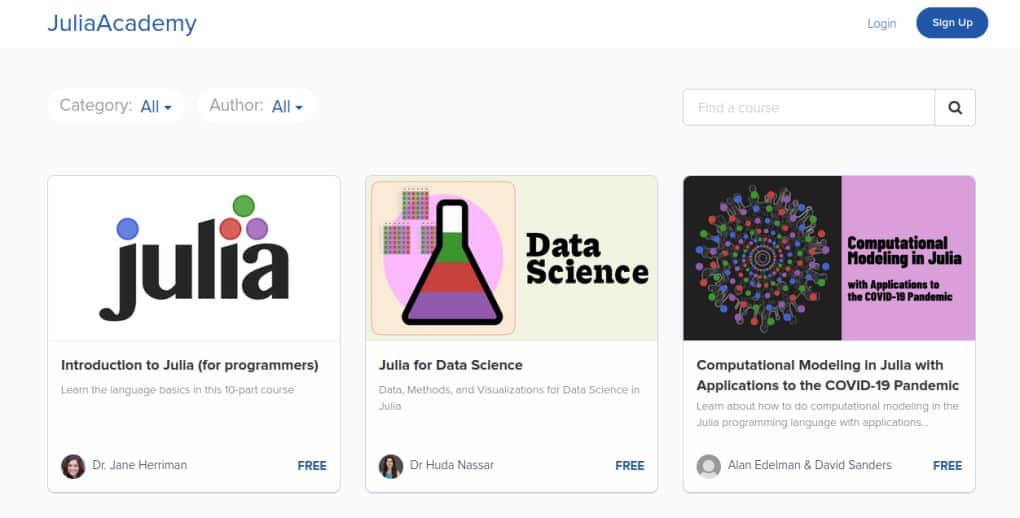
- Resource Type: Courses
- Price: Free
- Audience: All audiences
JuliaAcademy is a learning resource recommended by the Julia development team. On the JuliaAcademy site, you will find courses covering how to get set up with Julia, how to use Julia for data science, and the basics of machine learning with Julia.
Taught by the people who helped create Julia, this resource is an excellent source whether you are completely new to Julia or whether you have some knowledge of Julia and want to learn more. Each course features videos which walk you through the concepts you need to know.
The Julia Manual
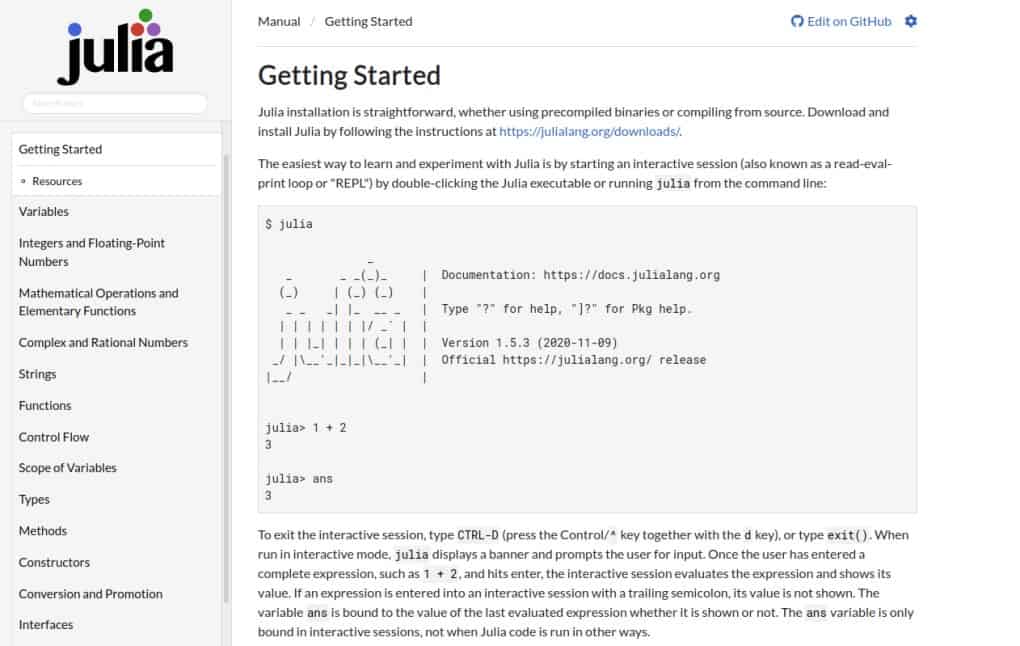
- Resource Type: Documentation
- Price: Free
- Audience: All audiences
The Julia Manual is the official documentation hub for the Julia language. The documentation is a great point of reference and walks you through all the essential Julia concepts, from basic syntax to declaring variables to working with multi-dimensional arrays.
Because the Julia Manual was written by people who have worked on the language, you are bound to pick up a thing or two about Julia even if you are already familiar with the language. For beginners, you can be assured that what you learn is accurate and up-to-date because the documentation is well-maintained.
Julia Exercism.io Challenges
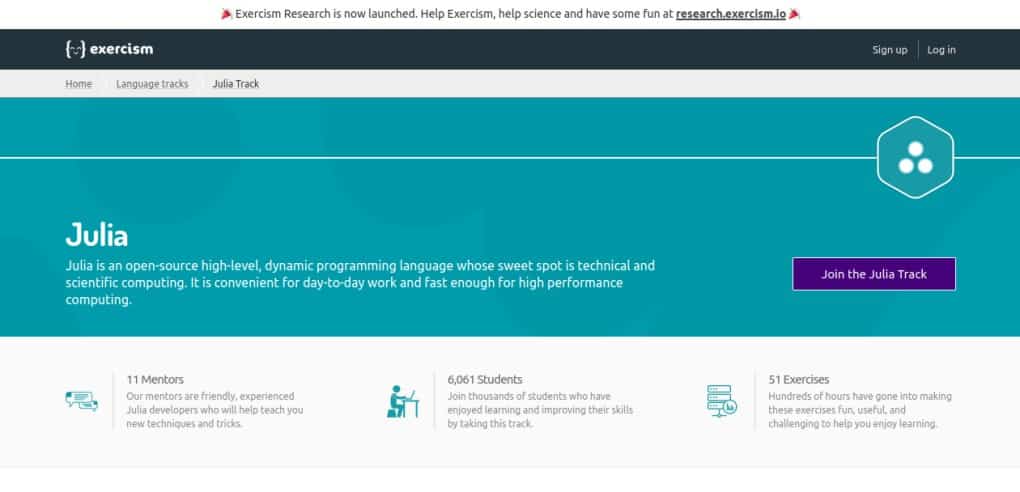
- Resource Type: Interactive challenges
- Price: Free
- Audience: All audiences
Exercism.io is a site featuring programming challenges in various languages. In the Julia track, there are 55 programming exercises to help you build your skills. This course has 11 mentors from whom participants can request feedback and support. All of the mentors are accomplished developers with experience using the Julia programming language.
Think Julia by Ben Lauwens and Allen B. Downey
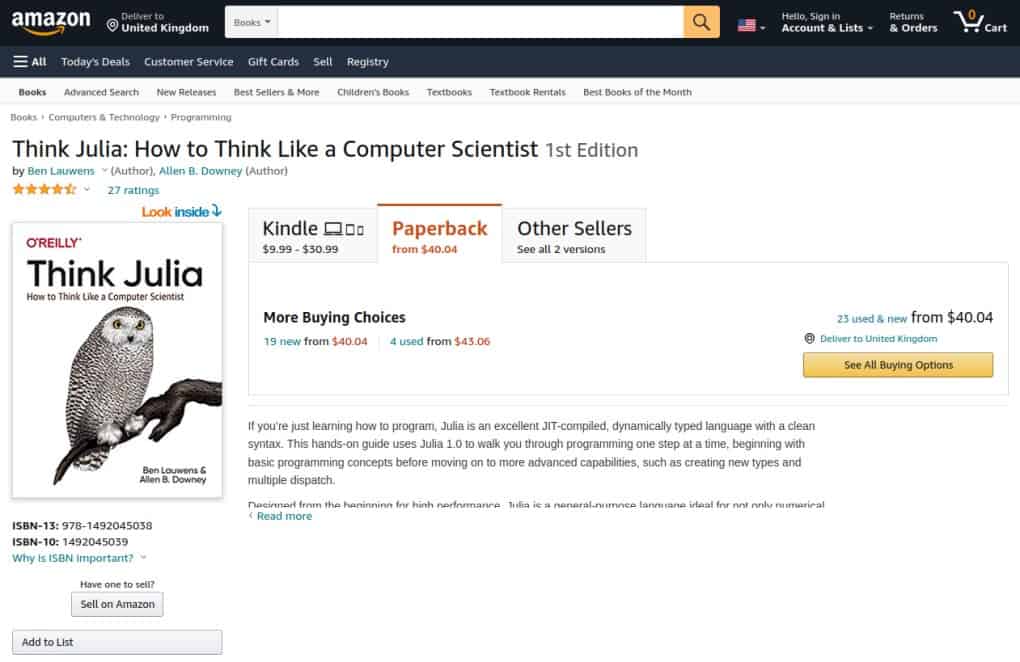
- Resource Type: Book
- Price: $40.04
- Audience: Beginners
Think Julia is aimed at beginners who want to learn the basics of the language, including high school and college students and those who are teaching themselves. In the book, you will learn what you need to know to write some basic Julia programs, from the basic syntax of Julia to values, data structures, and working with files.
From zero to Julia! By Aurelio Amerio
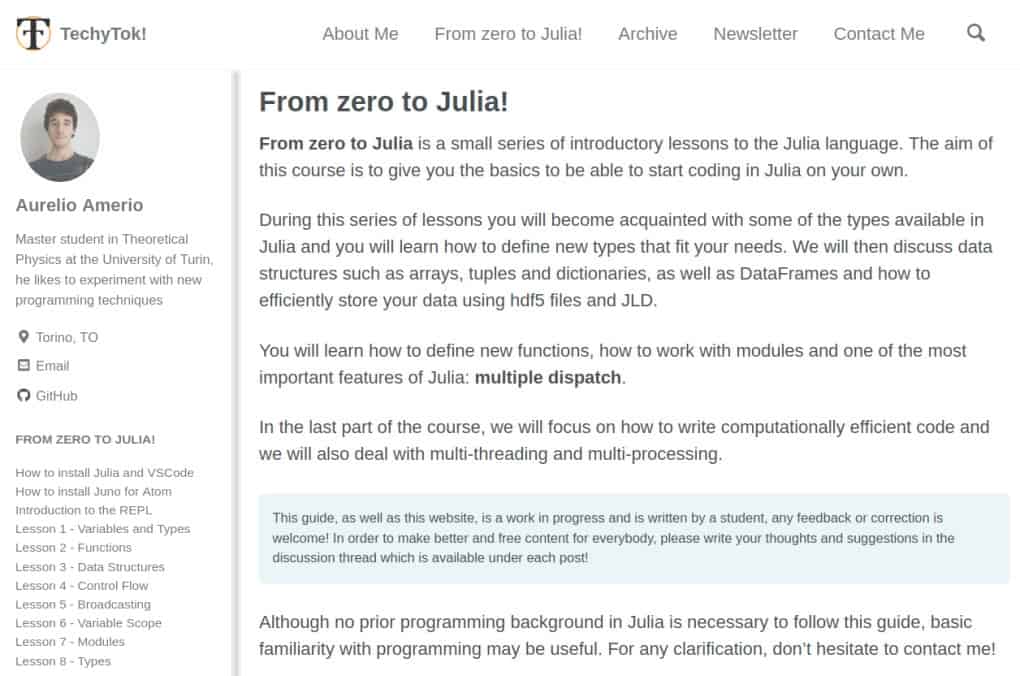
- Resource Type: Tutorial series
- Price: Free
- Audience: All audiences
From zero to Julia! is a series of blog posts on how to use the Julia language. The posts start with beginner topics like functions and variables. Then, you can go on to learn more advanced features of Julia such as optimizing your code, plotting, and multiple dispatching.
Each post in the tutorial series contains in-depth analysis on the subject matter of the post, accompanied by code snippets when relevant. These code snippets will help you get going as you learn new topics from this series.
Communities for People Studying Julia
Official Julia Discourse
The Julia Discourse is a web forum for Julia users. In this forum, you can ask questions, answer existing questions, or search through the wide range of existing answers. The community features threads on tooling, using Julia with statistics, getting started, and Julia finance projects.
Official Julia Slack
The official Julia Slack is a place to interact with other Julia developers. The Julia team recommends that you post programming questions in the Discourse section so that those questions can be accessed by others because it can be hard to find messages in Slack. This Slack group is a great place if you want to meet new Julia developers or stay connected to what is going on in the Julia community.
Julia Stack Overflow
The Julia Stack Overflow page contains over 8,000 questions related to Julia. The forum is active, with people posting questions and answers on a frequent basis. Topics covered on the forum range from issues to questions about how to accomplish a certain task in the Julia language. This community is a good place to go in addition to the Discourse community if you need to find an answer to a question you have.
How Hard is It to Learn Julia?
The Julia language is considered quite a difficult language to learn because the syntax is not as simple as that of other languages. Also, there are fewer study materials than you may find for a language like Python or C, which have both been around for years longer than JUlia. With that in mind, it is possible to learn Julia, even if Julia is going to be the first language you learn.
Will Learning Julia Help Me Find a Job?
Julia may be a newer programming language but the language has grown in popularity over the years. Indeed, Julia is an excellent language for data science; as data science as a field has grown, so too has interest in technologies for data science.
To help you discover how learning Julia will impact your career, we have prepared a few statistics on Julia in the job market:
- Salaries. According to PayScale, the average developer who has knowledge of Julia earns $81,372. Occupations that list Julia as a skill include data scientist, data analyst, senior research scientist, and software engineer.
- Job Openings. According to Glassdoor, there are 29,378 open jobs for a data scientist, the occupation in which Julia is most likely to be used.
- Industry Growth. Employment for computer and information research scientists is expected to grow at a rate of 15% between 2019 and 2029, according to the U.S. Bureau of Labor Statistics. This category includes data scientists, but also other computer research occupations.
Conclusion: Should You Learn Julia?
The Julia programming language was written for numerical computing and data science. The language is fast and has an extensive range of community resources, from an official web forum to online courses. These resources will help you get on your feet while learning Julia and answer any questions you have about the language.
Whether you decide to learn Julia is up to you. If you do not plan to work in a data-driven role, learning Julia may not be useful. The language is great for data science purposes and any use case that involves more complex computations. You should have no trouble finding an employer who values your Julia skills as long as you devote the right amount of time and energy to learning the Julia programming language.


